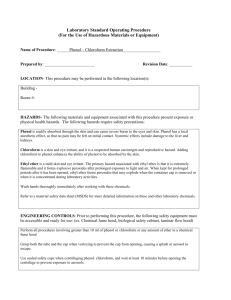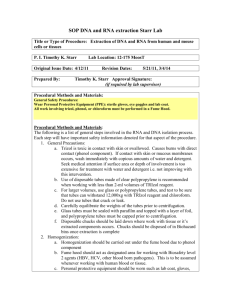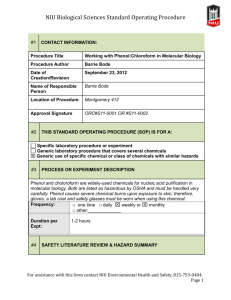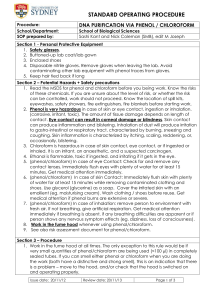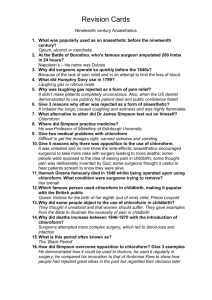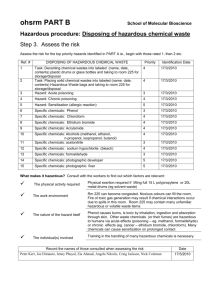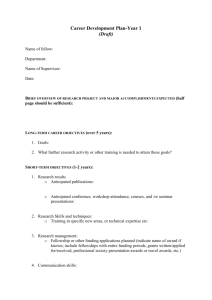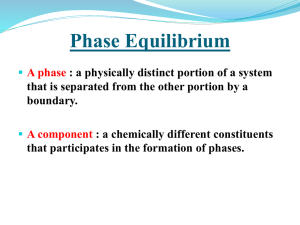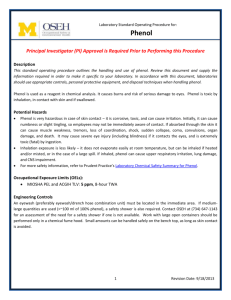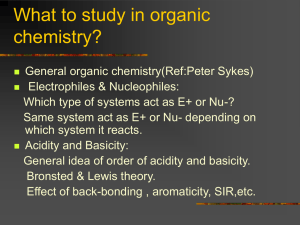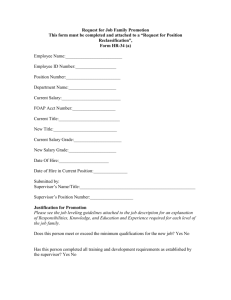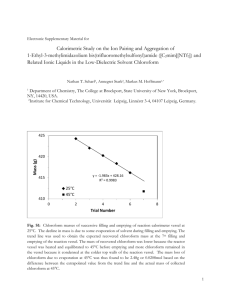doc
advertisement
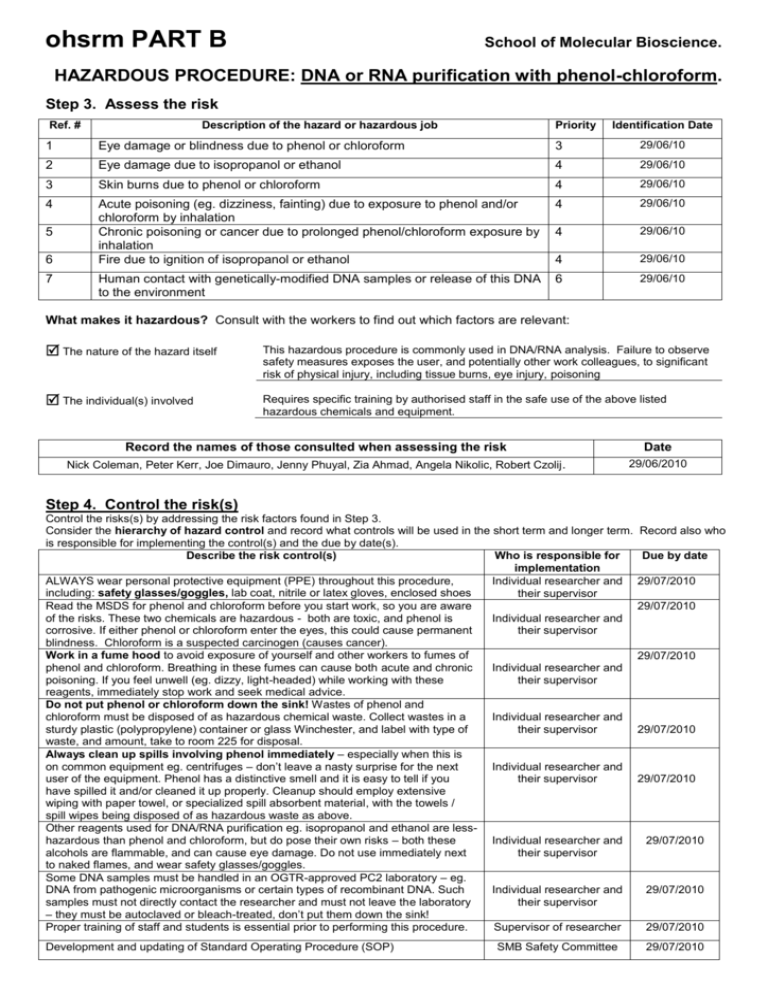
ohsrm PART B School of Molecular Bioscience. HAZARDOUS PROCEDURE: DNA or RNA purification with phenol-chloroform. Step 3. Assess the risk Ref. # Description of the hazard or hazardous job Priority Identification Date 1 Eye damage or blindness due to phenol or chloroform 3 29/06/10 2 Eye damage due to isopropanol or ethanol 4 29/06/10 3 Skin burns due to phenol or chloroform 4 29/06/10 4 Acute poisoning (eg. dizziness, fainting) due to exposure to phenol and/or chloroform by inhalation Chronic poisoning or cancer due to prolonged phenol/chloroform exposure by inhalation Fire due to ignition of isopropanol or ethanol 4 29/06/10 4 29/06/10 4 29/06/10 Human contact with genetically-modified DNA samples or release of this DNA to the environment 6 29/06/10 5 6 7 What makes it hazardous? Consult with the workers to find out which factors are relevant: The nature of the hazard itself This hazardous procedure is commonly used in DNA/RNA analysis. Failure to observe safety measures exposes the user, and potentially other work colleagues, to significant risk of physical injury, including tissue burns, eye injury, poisoning The individual(s) involved Requires specific training by authorised staff in the safe use of the above listed hazardous chemicals and equipment. Record the names of those consulted when assessing the risk Date Nick Coleman, Peter Kerr, Joe Dimauro, Jenny Phuyal, Zia Ahmad, Angela Nikolic, Robert Czolij . 29/06/2010 Step 4. Control the risk(s) Control the risks(s) by addressing the risk factors found in Step 3. Consider the hierarchy of hazard control and record what controls will be used in the short term and longer term. is responsible for implementing the control(s) and the due by date(s). Describe the risk control(s) Who is responsible for implementation ALWAYS wear personal protective equipment (PPE) throughout this procedure, Individual researcher and including: safety glasses/goggles, lab coat, nitrile or latex gloves, enclosed shoes their supervisor Read the MSDS for phenol and chloroform before you start work, so you are aware of the risks. These two chemicals are hazardous - both are toxic, and phenol is Individual researcher and corrosive. If either phenol or chloroform enter the eyes, this could cause permanent their supervisor blindness. Chloroform is a suspected carcinogen (causes cancer). Work in a fume hood to avoid exposure of yourself and other workers to fumes of phenol and chloroform. Breathing in these fumes can cause both acute and chronic Individual researcher and poisoning. If you feel unwell (eg. dizzy, light-headed) while working with these their supervisor reagents, immediately stop work and seek medical advice. Do not put phenol or chloroform down the sink! Wastes of phenol and chloroform must be disposed of as hazardous chemical waste. Collect wastes in a Individual researcher and sturdy plastic (polypropylene) container or glass Winchester, and label with type of their supervisor waste, and amount, take to room 225 for disposal. Always clean up spills involving phenol immediately – especially when this is on common equipment eg. centrifuges – don’t leave a nasty surprise for the next Individual researcher and user of the equipment. Phenol has a distinctive smell and it is easy to tell if you their supervisor have spilled it and/or cleaned it up properly. Cleanup should employ extensive wiping with paper towel, or specialized spill absorbent material, with the towels / spill wipes being disposed of as hazardous waste as above. Other reagents used for DNA/RNA purification eg. isopropanol and ethanol are lesshazardous than phenol and chloroform, but do pose their own risks – both these Individual researcher and alcohols are flammable, and can cause eye damage. Do not use immediately next their supervisor to naked flames, and wear safety glasses/goggles. Some DNA samples must be handled in an OGTR-approved PC2 laboratory – eg. DNA from pathogenic microorganisms or certain types of recombinant DNA. Such Individual researcher and samples must not directly contact the researcher and must not leave the laboratory their supervisor – they must be autoclaved or bleach-treated, don’t put them down the sink! Proper training of staff and students is essential prior to performing this procedure. Supervisor of researcher Development and updating of Standard Operating Procedure (SOP) SMB Safety Committee Record also who Due by date 29/07/2010 29/07/2010 29/07/2010 29/07/2010 29/07/2010 29/07/2010 29/07/2010 29/07/2010 29/07/2010 Consult SOP before performing this hazardous procedure, and observe all risk control recommendations. Refer to MSDS or consult safety officer if further information is required. Individual researcher and their supervisor. Individual researcher and their supervisor. 29/07/2010 29/07/2010 Record the names of those consulted when deciding on risk control measures Nick Coleman, Peter Kerr, Joe Dimauro, Jenny Phuyal, Zia Ahmad, Angela Nikolic, Robert Czolij . PART B completed by: Nick Coleman Date: 29/06/2010 29/07/2010
